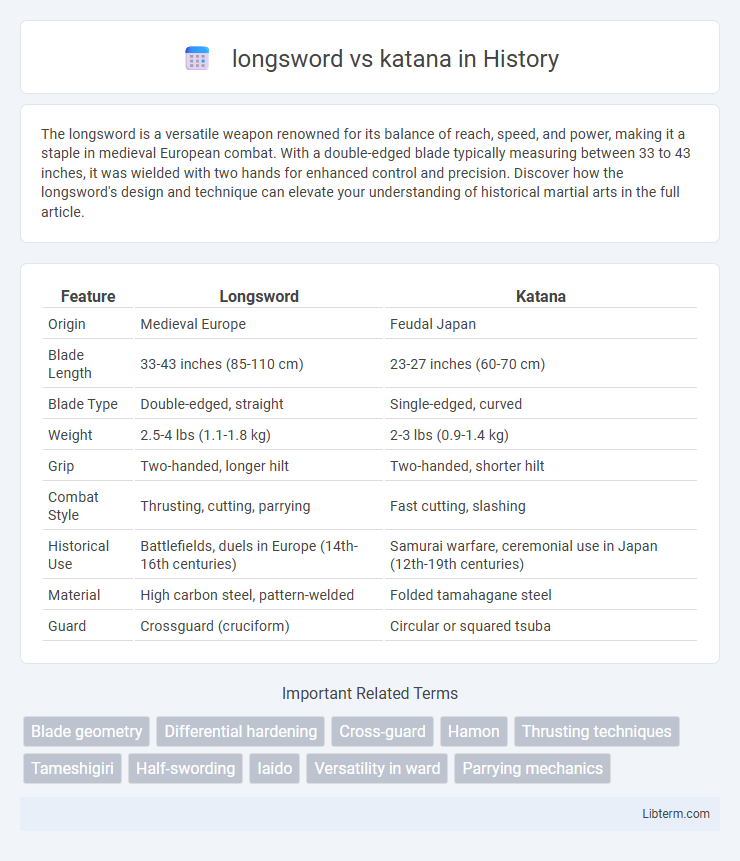The longsword is a versatile weapon renowned for its balance of reach, speed, and power, making it a staple in medieval European combat. With a double-edged blade typically measuring between 33 to 43 inches, it was wielded with two hands for enhanced control and precision. Discover how the longsword's design and technique can elevate your understanding of historical martial arts in the full article.
Table of Comparison
| Feature | Longsword | Katana |
|---|---|---|
| Origin | Medieval Europe | Feudal Japan |
| Blade Length | 33-43 inches (85-110 cm) | 23-27 inches (60-70 cm) |
| Blade Type | Double-edged, straight | Single-edged, curved |
| Weight | 2.5-4 lbs (1.1-1.8 kg) | 2-3 lbs (0.9-1.4 kg) |
| Grip | Two-handed, longer hilt | Two-handed, shorter hilt |
| Combat Style | Thrusting, cutting, parrying | Fast cutting, slashing |
| Historical Use | Battlefields, duels in Europe (14th-16th centuries) | Samurai warfare, ceremonial use in Japan (12th-19th centuries) |
| Material | High carbon steel, pattern-welded | Folded tamahagane steel |
| Guard | Crossguard (cruciform) | Circular or squared tsuba |
Longsword vs Katana: An Overview
The longsword, characterized by a double-edged blade measuring 33 to 43 inches, offers versatile thrusting and cutting capabilities suited for European medieval combat. The katana, with a curved, single-edged blade typically around 27 to 29 inches, emphasizes swift, precise slicing techniques integral to Japanese samurai warfare. Differences in blade geometry, weight distribution, and fighting styles highlight the longsword's adaptability in armored combat and the katana's efficiency in fluid, close-quarter encounters.
Historical Origins and Cultural Background
The longsword, originating in medieval Europe between the 13th and 15th centuries, was primarily used by knights and soldiers in warfare and dueling, characterized by its double-edged blade and cruciform hilt. The katana, developed in Japan during the Kamakura period (12th-14th centuries), became the iconic weapon of the samurai, featuring a single-edged, curved blade optimized for quick, precise cuts. Both weapons reflect their distinct cultural contexts: the longsword symbolizes European chivalric and martial traditions, while the katana embodies the samurai code of honor and Japanese craftsmanship.
Blade Design and Construction
The longsword features a double-edged, straight blade typically ranging from 33 to 43 inches, crafted from high-carbon steel with a tapered point for both cutting and thrusting. The katana boasts a curved, single-edged blade around 23 to 27 inches long, made through differential heat treatment (hamon) on tamahagane steel to create a hard cutting edge and a flexible spine. This contrast in blade design reflects divergent combat styles: the longsword excels in versatile strikes and thrusts, while the katana prioritizes precise slicing and swift draw cuts.
Weight and Balance Comparison
The longsword typically weighs between 2.5 to 4 pounds, with a well-balanced center of gravity near the hilt, designed for versatile two-handed use and precise strikes. In contrast, the katana generally weighs around 2.2 to 3 pounds and features a balance point closer to the guard, allowing for swift, fluid cuts and enhanced maneuverability. This difference in weight distribution reflects the distinct fighting styles and combat applications of these iconic blades.
Techniques and Fighting Styles
Longsword techniques emphasize versatile, two-handed strikes, thrusts, and defensive guards grounded in historical European martial arts, focusing on leverage and precise control. Katana fighting styles, derived from Japanese kenjutsu and kendo, prioritize fluid, swift, and cutting motions, with an emphasis on drawing and striking in a single motion (iaijutsu). Both weapons demand distinct tactical approaches: the longsword's broader range of guards and half-swording contrasts with the katana's emphasis on timing, rhythm, and quick, decisive cuts.
Damage Potential and Cutting Ability
The longsword offers high damage potential due to its weight and leverage, enabling powerful strikes with both edges and thrusts. Its broad blade design allows effective cutting and slashing, especially against armored or resilient targets. In contrast, the katana's curved blade excels in precision and cutting ability, delivering swift, clean slices with minimal resistance, optimized for cutting through unarmored or lightly armored opponents.
Defensive Capabilities
The longsword offers versatile defensive capabilities with its extended reach and ability to perform parries, blocks, and deflections effectively, making it ideal for close to mid-range combat. The katana's design excels in quick, precise parries and counter-attacks, utilizing its curved blade to redirect opponent strikes with fluid motion. While the longsword provides robust defensive coverage through its weight and length, the katana emphasizes agility and speed for defensive maneuvers.
Training and Mastery Requirements
Mastering the longsword demands extensive training in historical European martial arts (HEMA) involving drills in cutting, thrusting, and defensive techniques that emphasize strength and precision. Katana training, rooted in traditional Japanese koryu and modern kendo, prioritizes fluid motion, speed, and disciplined kata practice to develop muscle memory and mental focus. Both weapons require years of dedicated practice to achieve proficiency, but the longsword often involves more varied combat scenarios, whereas katana training stresses spiritual and cultural elements alongside physical skill.
Popular Myths and Misconceptions
Popular myths about longswords often portray them as slow and cumbersome, whereas historical evidence shows skilled swordsmen achieved remarkable speed and precision with these versatile weapons. Misconceptions about katanas depict them as magically superior blades, yet metallurgical studies reveal that their strength and sharpness result from specific folding techniques, not supernatural qualities. Both weapons require extensive training and technique, debunking the myth that either sword guarantees victory purely by its design.
Which Sword Reigns Supreme?
The longsword offers superior reach and versatility in combat with its double-edged blade and balanced weight, ideal for both cutting and thrusting techniques. The katana excels in speed and precision, featuring a curved, single-edged blade optimized for swift, lethal strikes and exceptional cutting power. Determining which sword reigns supreme depends on the combat context: longswords dominate in armored, versatile European battlefield scenarios, while katanas excel in swift, unarmored samurai engagements.
longsword Infographic

 libterm.com
libterm.com